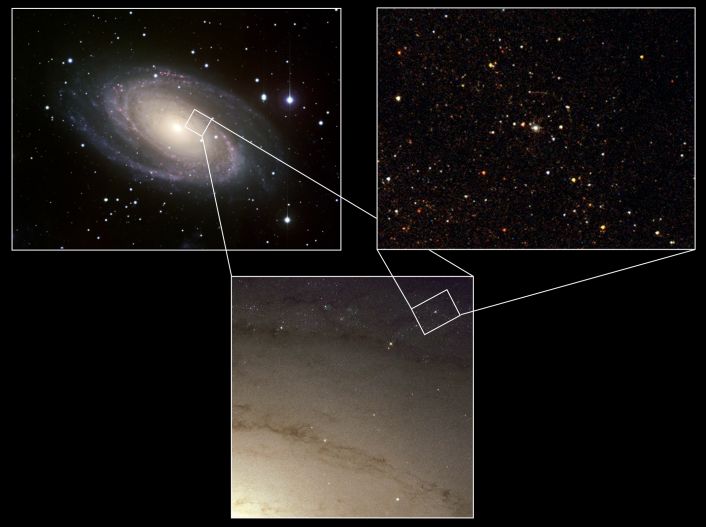Credit & Copyright: Justyn R. Maund (IoA/Univ. Cambridge)
et al.,
ESA
Inset Left: Isaac Newton Telescope,
Bottom: Hubble WFPC2,
Right: Hubble ACS
Explanation:
Beginning with a full view of beautiful spiral
galaxy M81,
follow the insets (left, bottom, then right) to
zoom in
on a real survivor.
Seen at the center of the final field on the right is a star
recently identified as the survivor of a cosmic cataclysm --
the supernova explosion of its companion star.
Light from the cosmic blast, likely triggered by the
core collapse of a star initially over 10 times as massive as the Sun,
first reached Earth over 10 years ago and was
cataloged as
supernova SN 1993J.
Though the supernova itself is no longer visible,
light-echoes from
dust in the region can still be seen near the companion, the first
known survivor of a
supernova
in a binary star system.
Astronomers believe that a substantial
transfer of material
to the surviving companion star during the last few hundred years
before the stellar explosion can explain peculiarities seen
in this
supernova.
After supernova SN 1987A in the
Large Magellanic Cloud, SN 1993J
in nearby M81 was the brightest supernova seen in modern times.
1999 2000 2001 2002 2003 2004 2005 2006 2007 2008 2009 2010 2011 2012 2013 2014 2015 2016 2017 2018 2019 2020 2021 2022 2023 2024 2025 |
Yanvar' Fevral' Mart Aprel' Mai Iyun' Iyul' Avgust Sentyabr' Oktyabr' Noyabr' Dekabr' |
NASA Web Site Statements, Warnings, and Disclaimers
NASA Official: Jay Norris. Specific rights apply.
A service of: LHEA at NASA / GSFC
& Michigan Tech. U.
|
Publikacii s klyuchevymi slovami:
supernova - binary star - M 81 - Sverhnovye - dvoinye zvezdy
Publikacii so slovami: supernova - binary star - M 81 - Sverhnovye - dvoinye zvezdy | |
Sm. takzhe:
Vse publikacii na tu zhe temu >> | |
